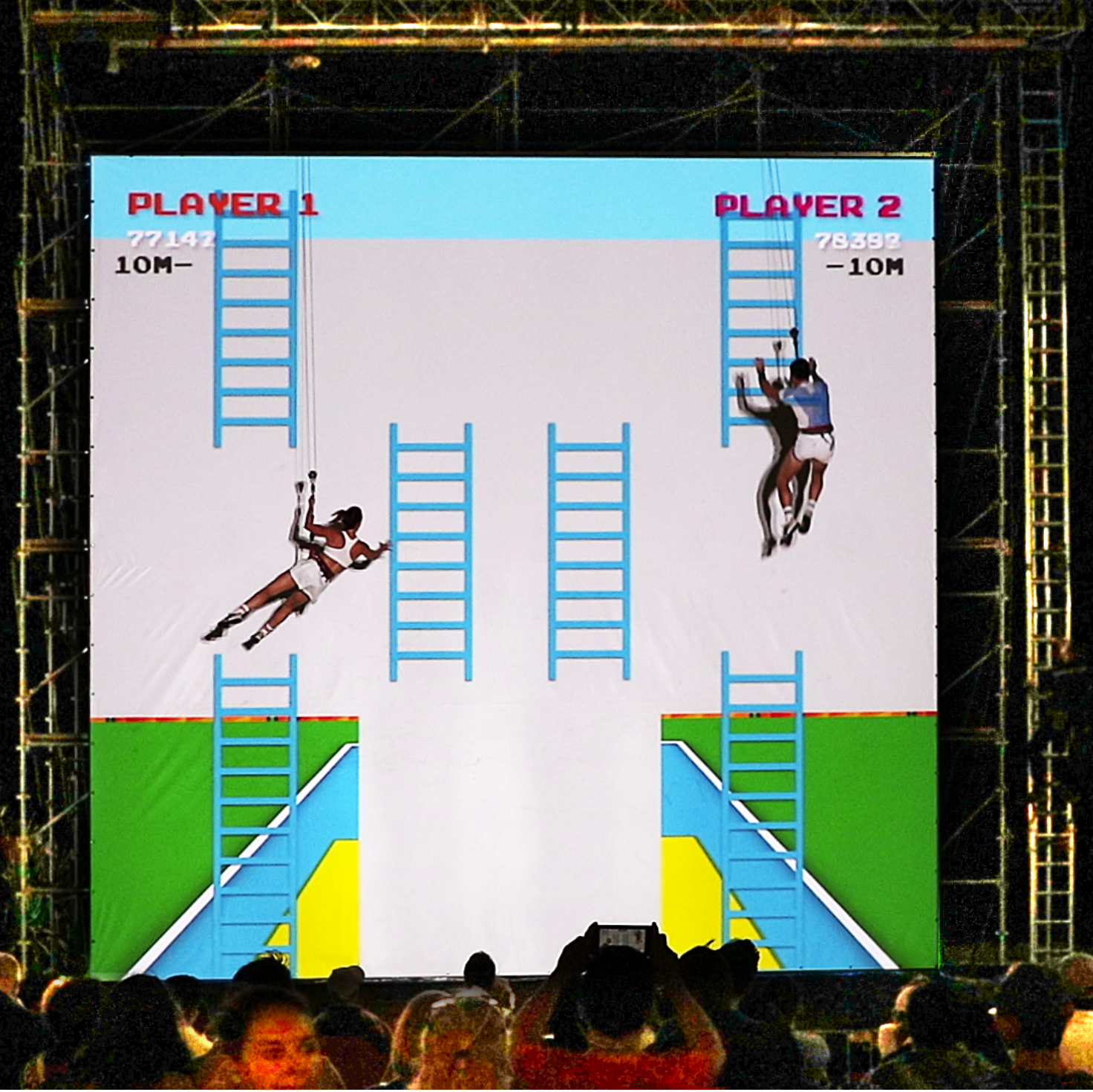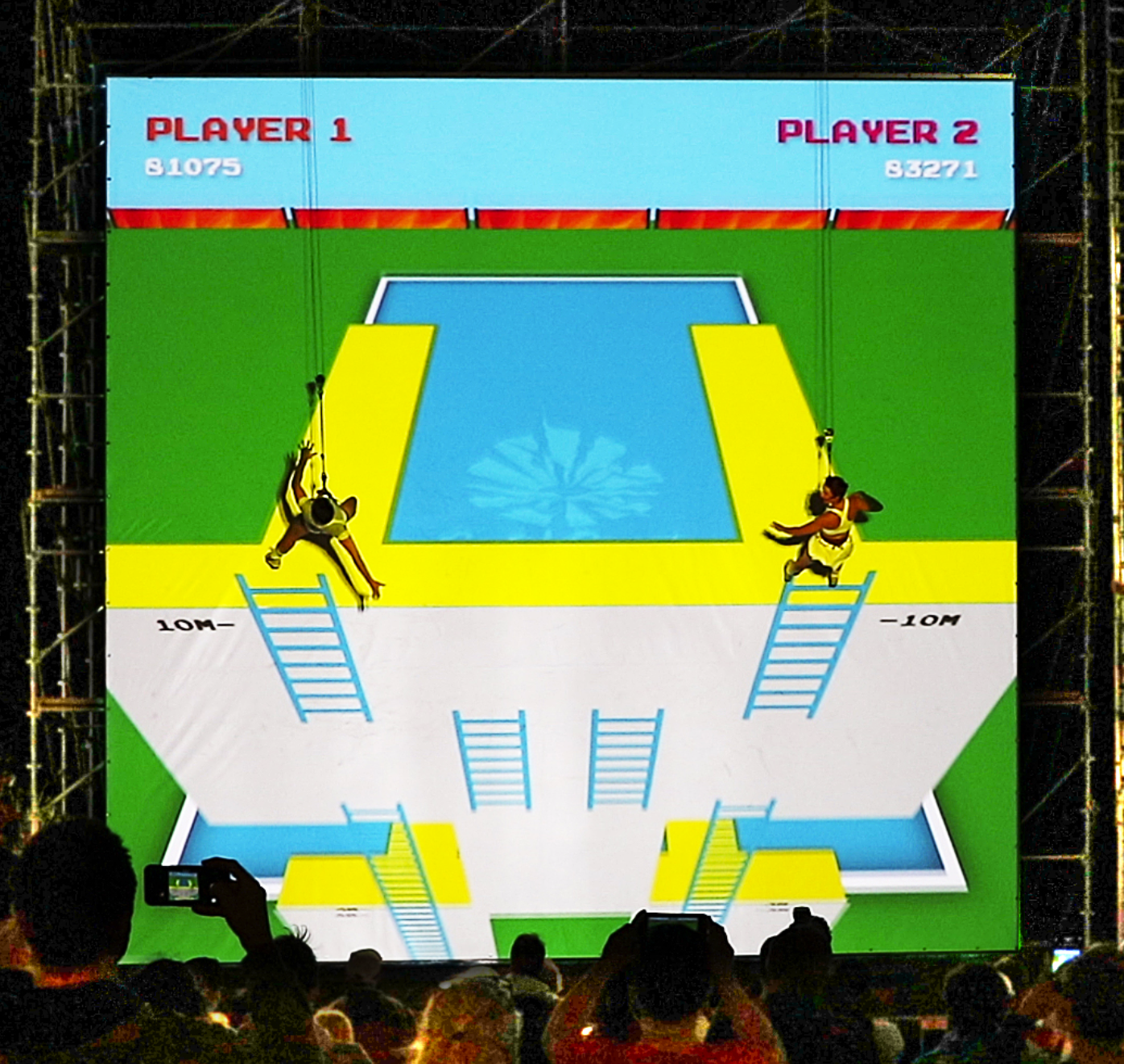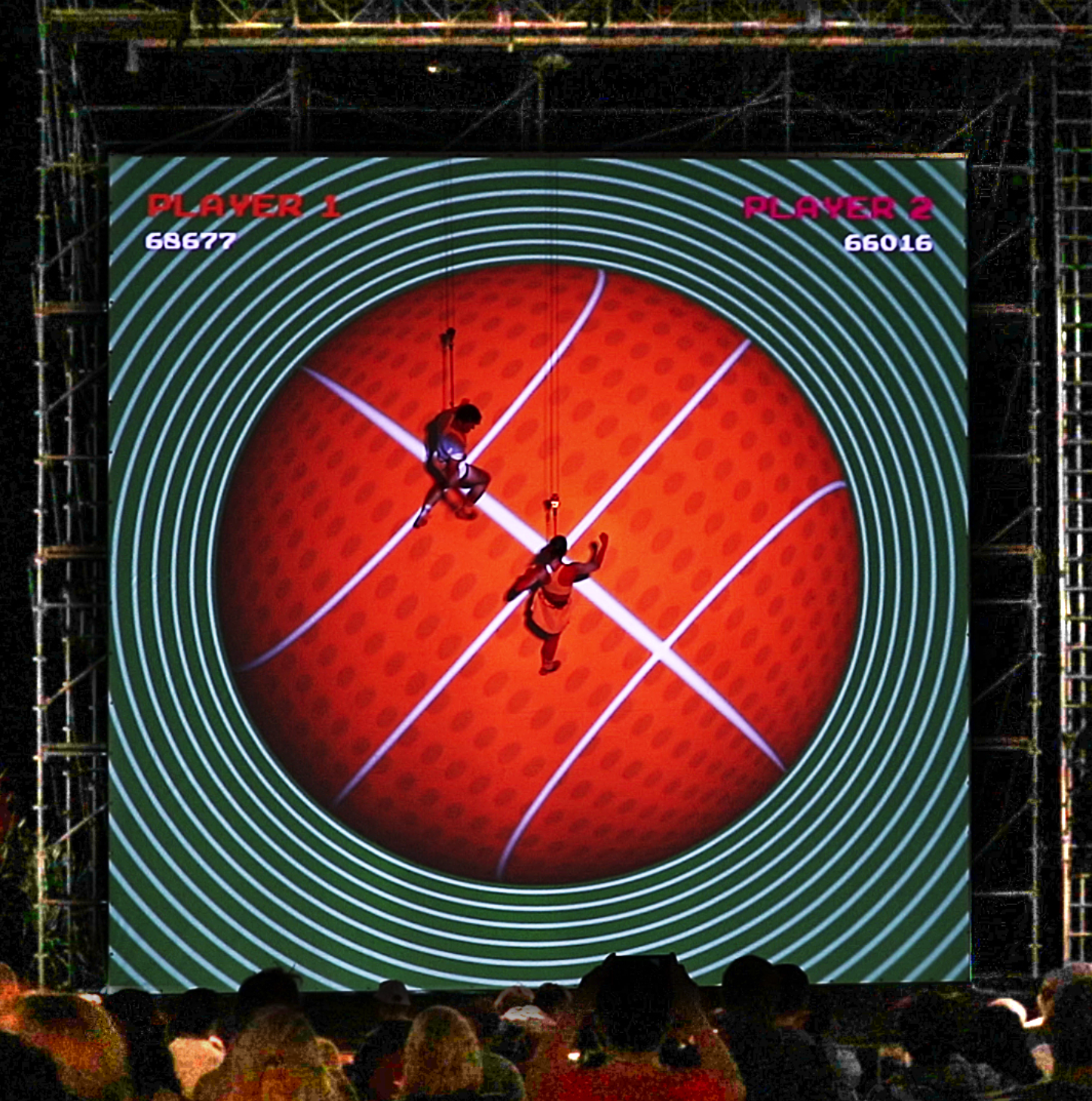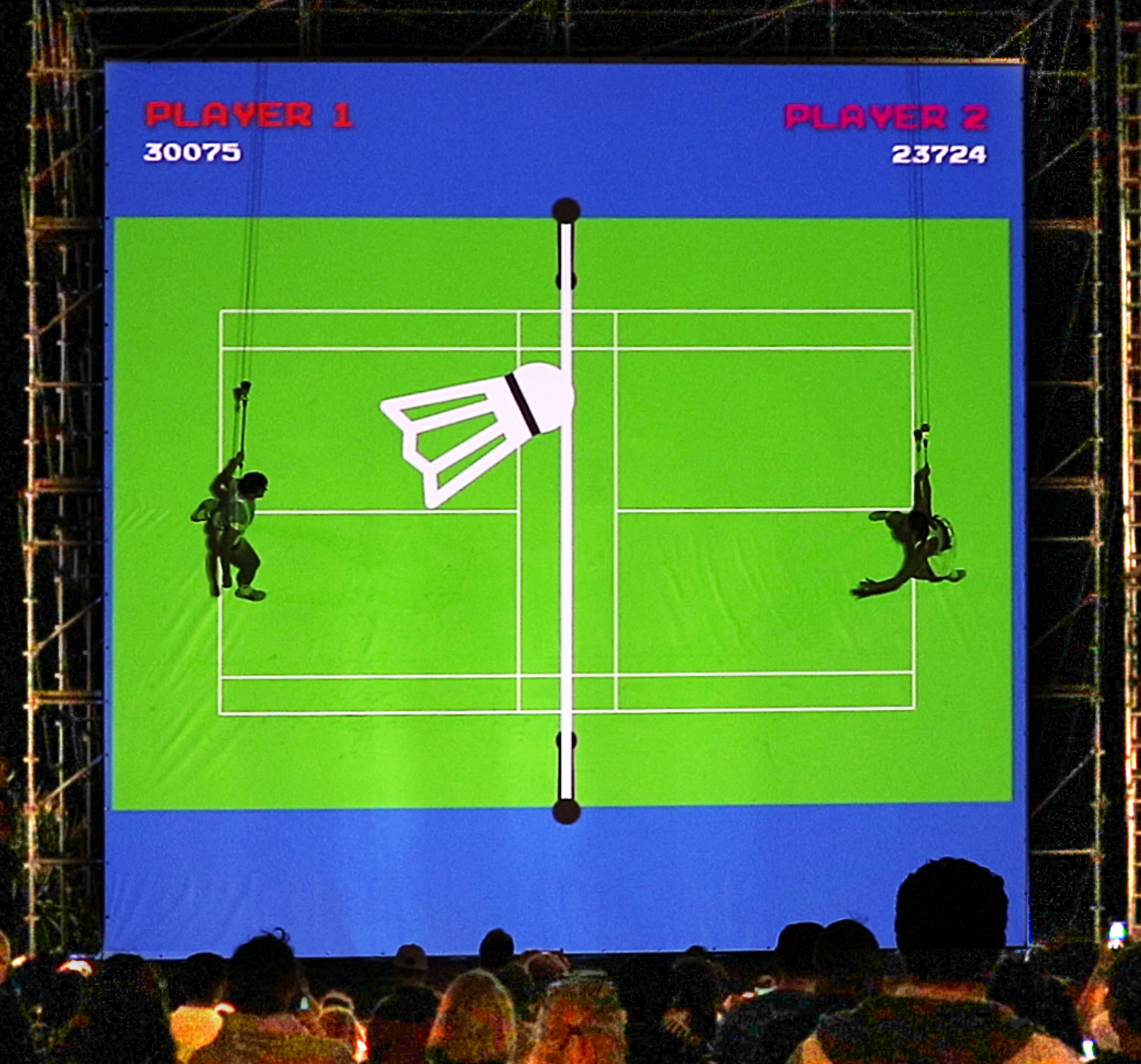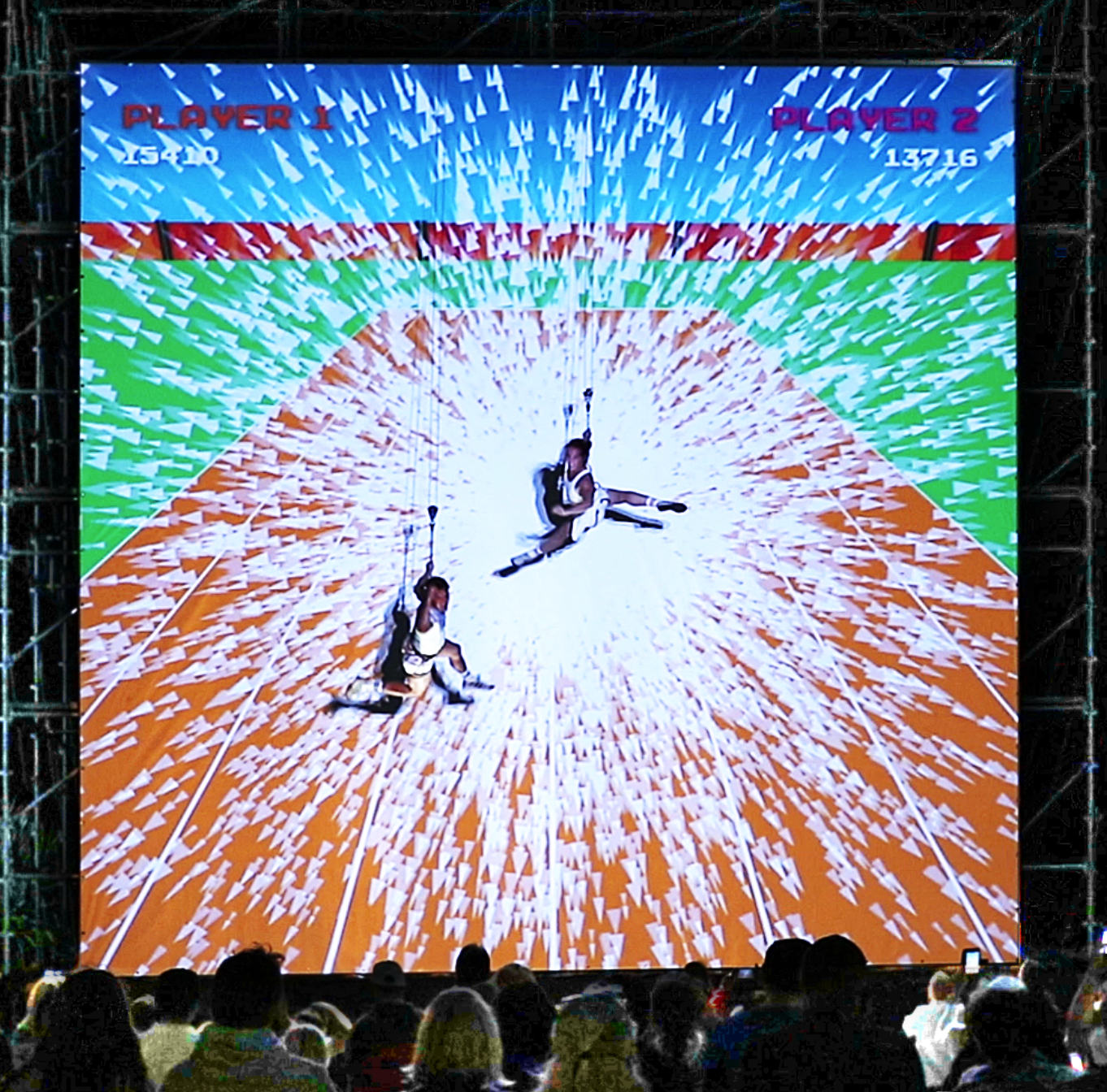peter thiedeke
image maker
Game On / The Gold Coast 2018 One Year to Go Community Celebration
Remix & the Apllied Arts / Projection mapping & live performance
Creative direction, concept and sound design: Peter Thiedeke
Animation and design: Todd Clausen @ Gurerrlla Digital
Performances: Joshua Thomson and Leeanne Litton of Legs on the Wall
Music: Various online remix artists
Projection: www.ikonix.net.au
Agency: Guerrilla Digital
Client: Gold Coast 2018 Commonwealth Games Corporation GOLDOC
The back story
This commissioned work was conceived of and designed as a solution in response to a specific visual communications problem. Commissioned by the Gold Coast 2018 Commonwealth Games Corporation (GOLDOC) for the 2018 One Year to Go Community Celebration on Tuesday, 4 April 2017 on the The Gold Coast, Surfers Paradise Beach and Esplanade, adjacent to Cavill Avenue. GOLDOC describes the work as “a gravity defying light projection show that will light up the night with a taste of the sports on offer at GC2018”.
This piece, although completed and having been exhibited, is still considered to be in the prototype phase. It was entirely constructed within digital software applications both online and offline. All of the imagery is original (excluding the GOLDOC's branding stinger) and the sound bites are licensed downloads. The extremely tight deadline of less than three weeks to design and deliver this project also required a creative solution that would be achievable with very limited (human) resources, myself, an animator, a dog and a large team of critics. The logical approach was that of Remix and the integration of highly malleable vector graphics, that could be repurposed during rapid prototyping and adjusted during the live online rehearsal / critiques sessions with the performance artists working on a purpose built wall in Sydney.
Live performance / projection 8m x 8m
Treatment: Practically, the visual treatment would solve the problem of representing the Commonwealth Games in a light, upbeat and humorous way that could be easily interpreted by a large cross section of the community. Conceptually in line with notion of games, quests and competition, I proposed the idea of creating a simplified lo-fi computer game space in which the aerial performers would be able to interact with once suspended from a tinkerbell rig that afforded them dynamic yet limited mobility when suspended above and adjacent to an 8 metre square vertically orientated (wall) stage.
Vector animation
Synopsis: Our heroes are on a mission to collect gold, facing the virtual challenges of an unstable, fourth dimensional virtual world. With nothing but gravity on their side they must complete their athletic quest and preserve the pride to their tribe. Within the tradition of the forced perspective and illusional representation of trompe l'oeil, playful perspectives and transformational scales create the illusional effect. The success or failure of the illusion is dependent on the timing and spatial accuracy of the performers - or the relative temporal and spatial juxtapositions of the real and virtual worlds.
Theoretical Context
In recent years, and within the long tradition of the forced perspective and illusional representation of trompe l'oeil, a number of trends have emerged in the field of image projection onto three dimensional objects. The emergence of projection mapping, video mapping and spatial augmented reality demonstrates a clear and common desire to break from the two-dimensional screen and the confines of the screen’s frame. These movements have become a mainstream form of indoor and outdoor image-based installation. Early examples of this form of visual illusionism were developed by Disneyland in the 1960’s and since the early 2000’s they have become widely adopted by artists and commercial image makers globally. However, a broader conceptual analysis of projected artworks that pre-date these relatively new and narrowly defined forms of spectacular visual illusionism is more useful in understanding their development.
Chrissie Iles’s (2001) chapter Between the Still and Moving Image, published on the occasion of the exhibition Into the light: the projected image in American art (1964-1977) at the Whitney Museum of American Art in New York, examines how the projected image in artworks of the 1960s and early 1970s were transformative in the artistic conceptualisation of physical space. She reflects on the work of a diverse group of minimalist artists who challenged traditional, physical and perceptual relationships between the screen and the viewer by engaging audiences through phenomenological experiences of hybrid works that broke with the structural traditions of the white cube and the black box. Through the deconstruction of the formal and temporal properties of the moving image, the screen and its surrounding space, these artists used sculptural projections, transparency and illusionism to destabilise the image plane and the viewers perceptual systems to re-define the very limits of illusion (p. 33 & 65).
Most of the artists who created these forms were also making works in other media, inducting sculpture, language, photography, neon, earthworks, drawing, film, sound, and performance, each of which informed the texture and form of the others and all united by an underlying temporality (Iles & Zummer, 2001).
Crowther (2008) suggests that digital art radicalises traditional arts capacity for the representation of the existing in that it can present nomological impossibilities and situations that would not be possible in real life, despite our inescapable awareness of its artifice and technological origins (p. 164). He further claims that this direction in visual representation has far reaching transformational consequences for the nature of visual art itself (p. 167). Manovich (2001) assumes that illusionistic representations in visual culture were rejected by art in the 20th century and relegated to the domain of photography, film, and video (p. 177). Declaring a paradox of digital visual culture, he posits that as lens-based imagery came to dominate modern visual culture, there was also a gradual turn of computer imaging towards the representational and the photo realistic. He attests that, while the realism associated with lens-based imagery shares many qualities with natural perception (p. 180), the realism associated with computer-based imagery is qualitatively different because ‘simulated reality is not indexically related to the existing world’ (p. 184). He also attributes a reality effect to the synthetic image, which is only partially dependant on its appearance. The new media user, he determines, is actively involved with other dimensions including bodily motion, engagement with audio, touch and the simulation of physics and other natural phenomena and interactivity changes our concept of what an image is (p. 181-183). Manovich’s conclusions pose great opportunities for digital photography as it transforms through its convergence with other media -
Synthetic computer-generated imagery is not an inferior representation of our reality but a realistic representation of a different reality […] the synthetic image simply represents the future, in other words if a traditional photograph always points to a past event, a synthetic photograph points to a future event (Manovich, 2001, p. 202-203).
Manovich (2001) refers to three conceptual distinctions of screen types classical, real-time and dynamic screens. He categorises these three types of screen in relation to the temporal and spatial dimensions of a viewer’s body space and the screen space that exists as a window of representation. The classical, a flat rectangular surface in which all other screens are a subtype, categorises the frontal viewing of static and permanent representations including painting and “this space of representation typically has a scale different from the scale of our normal space” (p.95). Real-time screens show the present as the image can be updated in real-time (p.103) in which case, according to Manovich, the static image no longer exists because different parts of the image on real-time screens correspond to different moments in time and they are represented in real-time through sequential scanning. The dynamic screen displays an image changing over time or a moving image of the past and the relationship of spectator to this screen can be conceptualised in different ways. The computer screen, which displays a number of co-existing windows and images of which neither completely dominates the viewer’s attention and the VR screen, which disappears at the coincidence of the real and the virtual spaces disrupting the spatial relationship between viewer and screen. Fully situated within the virtual space and without a screen frame to reference the window and separate the two spaces, the viewer is no longer immobilised and has to move to experience motion (p. 109), however, even within virtual reality we still remain connected to the screen -
The long history of the body’s imprisonment continues […] for now we clearly live in the society of the screen […] we are still looking at flat, rectangular surface, existing in the space of our body and acting as window into another space (Manovich, 2011 p. 114 &115).
Defining the specific characteristics of the digital image and the relationships of these characteristics to each other in technological terms appears to lead to many questionable and loaded assumptions, in particular the notion that we are being liberated by technologies. The volatility of this concept is compounded by limited understandings of the constraints of emerging software and hardware devices, the capacity of our senses and our inability to perceptually comprehend spatial and temporal dimensions beyond the third dimension. These variables are even further coloured by disciplinary and cultural bias towards accepting how the image can be described. The material and the immaterial, the spatial and the temporal, the interactive and the immersive are all extremely useful theoretical frameworks for the construction and deconstruction of imagery and our experience of images. If the re-imagining of hybrid imagery is only limited by the convergence of media, the breaking of disciplinary boundaries, the immaterial linking of the material through the dynamic hardware and software based processes, the unlimited aesthetic iterations, the breaking of the screen and the endless conceptual re-interpretations then we are off to a good start. However, the more malleable the image and the deeper the interventionist remix, the greater the complexity in its production, dissemination and interpretation. This certainly implies that the photographic image, with its perceived indexical relationship to reality, is compromised. If the giving way of the lens to the purity of illusion, it’s temporal reversal from a representation of the past to one of the future, the breaking of the traditions of the image plane with its the single viewpoint and the transcendence of the image from the screen’s frame are all deemed acceptable, then the production of new hybrid photographic image forms that may be experienced independently of screens may be within the scope of probability.
I would further speculate that a practice where the material and the immaterial convergence could occur outside of software applications, where the spatial may take privilege over the temporal in radicalised subjective and physical spaces (or both simultaneously), where the linear becomes interchangeable with the non-linear and the viewers awareness of the possibility of an extra-dimensional and corporeal experience of volume without mass, may well exist in a reality that need not be virtual.
Crowther, P. (2008). Ontology and Aesthetics of Digital Art. The Journal of Aesthetics and Art Criticism, 66(2), 161-170.
Iles, C., & Zummer, T. (2001). Into the light: the projected image in American art, 1964-1977: Whitney Museum of American Art New York.
Manovich, L. (2001). The language of new media. Cambridge, Mass: MIT Press
